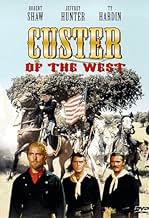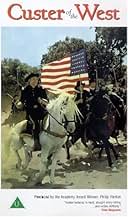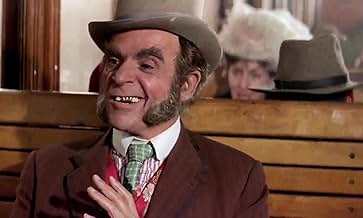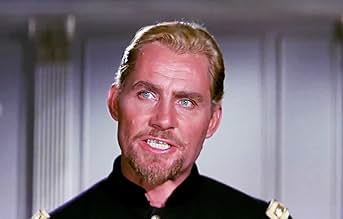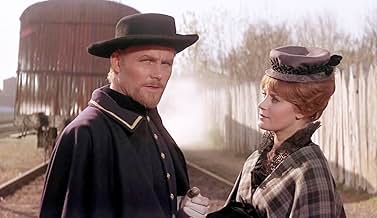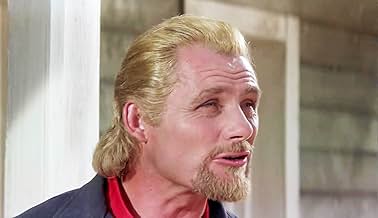Der extravagante Bürgerkriegsheld Custer übernimmt das Kommando über die 7. Kavallerie und will die Reservationspläne der vertragsbrüchigen US-Regierung gegen die aufsässigen Indianer mit Ge... Alles lesenDer extravagante Bürgerkriegsheld Custer übernimmt das Kommando über die 7. Kavallerie und will die Reservationspläne der vertragsbrüchigen US-Regierung gegen die aufsässigen Indianer mit Gewalt durchsetzen. Doch die wehren hartnäckig.Der extravagante Bürgerkriegsheld Custer übernimmt das Kommando über die 7. Kavallerie und will die Reservationspläne der vertragsbrüchigen US-Regierung gegen die aufsässigen Indianer mit Gewalt durchsetzen. Doch die wehren hartnäckig.
Empfohlene Bewertungen
The accent employed by Shaw is sometimes distracting, but it's not the liability some complain. Supporting performances are played with conviction, particularly Ty Hardin as the boozing Major, who finds Custer's work ethic an unwelcome interruption to his inertia, and Jeffrey Hunter as an Injun-sympathiser, the teacher drafted into the cavalry, looking for some semblance of moral justice amid the chaos. Needless to say, he resigns to futility, as does Custer in his final stand at Little Big Horn.
Perhaps the most revealing character trait chosen by Shaw in this interpretation, is his tendency to seek advice from his wife (Ure). Often absorbed by immense self doubt and political pressure, Ure is his constant sounding board. While this edge gives Shaw's Custer an interesting new dimension to an otherwise wholly glorified character in the movies to this point, it does largely waste Ure's talents as she rocks, knits and conjures pearls of wisdom for her conflicted husband to ponder. More liberty (e.g. removing the superfluous congress speech, the log-ride scene or the bizarre musical) with the guillotine could have cut 20-30 minutes off this epic tale, which is often paralysed by lengthy passages of dialogue and irrelevant plot diversions. Overall, while it certainly improves with each viewing, it's perhaps irrevocably flawed and overlong.
"Custer of the West" both stresses the mistreatment of the plain's Indians by the U.S. and portrays Custer as a tragic American hero who was a puppet of government policy. The film is usually lambasted for its inaccuracies, particularly its depiction of the closing battle. For instance, in real-life Custer's soldiers surprised the Native encampment, they didn't ride up and dialogue with the waiting Indians; moreover, the battle was a chaotic one, moving toward Last Stand Hill. Yet it's not like previous films were any more accurate, e.g. "They Died with Their Boots On" (1941), but audiences apparently demanded more accuracy by the late 60s.
Regardless, the gist of events is true: Reno and Benteen were real-life subordinate officers at odds with Custer and reportedly failed him on the day of battle, although they supposedly had justified cause. If I were Benteen, I would've probably done what he did in the face of Custer's glory-hound rashness and a formidable foe: Dig in, face the enemy, and survive to fight another day. In any case, if you want historical accuracy (to a point) see "Son of the Morning Star" (1991).
The main problem I have with this movie are the Spanish locations substituting for Virginia, the Dakotas and Montana. Fortunately, the creators at least tried to find a setting with trees for Virginia and some of the locations they used for Dakota/Montana occasionally work (just occasionally). But there's a long desert sequence when nothing of the sort exists in the region. You'd have to go far south to New Mexico/Arizona or way further west to eastern Washington to find such deserts. Yet it could be argued that the desert sequence is substituting for the Badlands of the Western Dakotas, which is certainly desert-like.
If you can ignore the disingenuous topographies, there's a lot to appreciate in "Custer of the West." But the film's overlong and bogged down by tedious or useless sequences, like the capture/imprisonment of Sgt. Mulligan (Robert Ryan). But there are some gems, like when Dull Knife (Kieron Moore) pays Custer a visit at the fort (which in real life didn't have a timber stockade). Custer bluntly conveys to the Chief the simple (awful) truth about conquerors and those they conquer: "The problem is precisely the same as when you Cheyenne decided to take another tribe's hunting ground. You didn't ask them about their rights. You didn't care if they had been there a thousand years. You just had more men and more horses. You destroyed them in battle. You took what you wanted and, right or wrong, for better or worse, that is the way things seem to get done. That's history."
FYI: Deviating from the original script, Robert Shaw made the character of Custer over to suit himself, turning him into a "sadist of Shakespearean depth." He also directed the battle scenes with Siodmak staging everything else.
THE MOVIE RUNS 2 hours 21 minutes and was mostly shot 30 miles from Madrid, Spain, except for the Battle of Little Bighorn which was filmed in Costa del Sol near Almira. WRITERS: Bernard Gordon and Julian Zimet with additional work by Shaw.
GRADE: C
This movie well produced by Philip Jordan blends good action scenes, shootouts , adventures and being quite entertaining , because happen many deeds and fast-moving and that's why it is neither boring , nor dreary, but entertaining . George Armstrong Custer's complex characterization with an unusual point of view is well performed by Robert Shaw who gives a nice embodiment of this Western hero. Robert Shaw's interpretation as a hippie-type, long-haired general , is top-notch , unfortunately he early died , in fact , this is his last film . His wife in the real life, Mary Ure being early dead , as well. The thrilling final confrontation between Custer army and Indians is spellbound and breathtaking similar to ¨ They died with the boots on (1941)¨ with Errol Flynn and directed by Raoul Walsh . The film obtained a limited success in spite of the lavish budget and spectacular sets . Direction by Robert Siodmak is average , in spite of a long career with many cinema classics (Criss Cross , The killers , The spiral staircase , The suspect) and the film is mediocre and overlong , too. The great director Fred Zinnemann even directed some scenes and originally to be directed by Akira Kurosawa, but he ruled out . Cecilio Paniagua's cinematography is glimmering and fascinating and photographed in Super Technirama 70 , the outdoor scenarios are overwhelming , this is the best of the film . Bernardo Segall musical's score is sensitive and moving and performed by Royal Philarmonic orchestra. Splendidly staged battles with obligatory cast of hundreds is well made by the art directors Eugene Lourie and Julio Molina . The motion picture will appeal to biopic enthusiasts and Indians western buffs.
Other adaptations about this historic character culminating in thrilling battle of Little Big Horn are the following ones : ¨Santa Fe trail¨ by Michael Curtiz with Ronald Regan as Custer ; ¨Great massacre Sioux¨ by Sidney Salkow with Philip Carey as Custer and Iron Eyes Cody as Crazy Horse ; ¨Little Big Man¨ by Arthur Penn with Richard Mulligan as Custer ; ¨Son of the morning star¨ TV miniseries by Mike Robe with Gary Cole , among others.
I think your enjoyment of "Custer of the West" depends a lot on what your opinions are of the man, if any. As a former US History teacher, I look on the man as a very failed (if not a bit stupid) leader...so since I am not a fan, it made enjoying the film more difficult. More difficult still is that the movie didn't do a lot to humanize the man or tell you who he was apart from some general/lieutenant colonel.
Overall, reasonably good but not exactly a crowd-pleaser.
Wusstest du schon
- WissenswertesSome sources have suggested that this was originally to be directed by Akira Kurosawa, but he pulled out. However, this is massively unlikely, given the production history of the film. The more likely explanation is that Kurosawa was approached about directing a different film project on the same subject, "The Day Custer Fell", which was in the works at 20th Century Fox for several years, and for which several Japanese actors famous for working with Kurosawa were approached to play the leading Native American roles. Fred Zinnemann was eventually attached to this project, but it was canceled by Fox because of its ever-escalating budget. "Custer Of The West" was put together very quickly (and made rather cheaply) once this occurred.
- PatzerThe troops of the 7th Cavalry are shown with 1873 Winchester rifles, which were in wide use by 1876, but not by the US Army. Custer's men were armed, as all troopers who did not purchase their own rifles were, with the 1873 Springfield Trapdoor carbine, a single-shot weapon. Had Custer's men been armed with the Winchester, it is possible, though unlikely, that they could have held out until relieved.
- Zitate
Gen. Philip Sheridan: You know, you could become a living legend... or get yourself killed. Dead men make better legends.
- Alternative Versionen35mm prints released in both complete and shortened versions. Some shortened versions were titled "A Good Day for Fighting".
- VerbindungenFeatured in I Am Not Your Negro (2016)
Top-Auswahl
- How long is Custer of the West?Powered by Alexa
Details
- Erscheinungsdatum
- Herkunftsländer
- Sprache
- Auch bekannt als
- Last Post - US Kavallerie Western-Klassiker Box
- Drehorte
- Produktionsfirmen
- Weitere beteiligte Unternehmen bei IMDbPro anzeigen
Box Office
- Budget
- 4.000.000 $ (geschätzt)
- Laufzeit2 Stunden 20 Minuten
Zu dieser Seite beitragen


